

 |
Return to the page for Rudolf Lowenstein's Visit to Dallas |
 |
Return to the Index for 2014 |
Today, it is a little cooler than yesterday, so for our second major outing during Rudolf's visit, Fred and I are going to take him over to the Dallas Arboretum. Rudolf has been there before, but he, and we, always enjoy wandering through the gardens.
Getting to the Dallas Arboretum
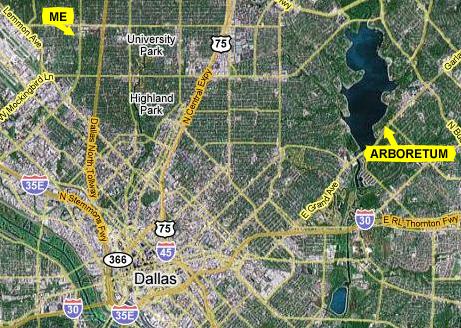 |
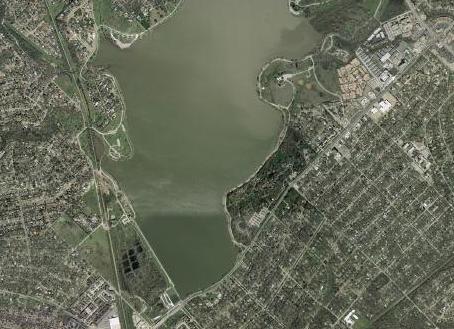 |
The bike path used to cross the top of the dam, but for one reason or another, the bike path was rerouted a year ago, and now it goes through some parkland and playing fields south of the dam, across the spillway, up Garland Road for a ways, and then back north along the lake shore.
You can also see a closer view of the Arboretum in this picture, and can begin to pick out some of the pathways through the gardens.
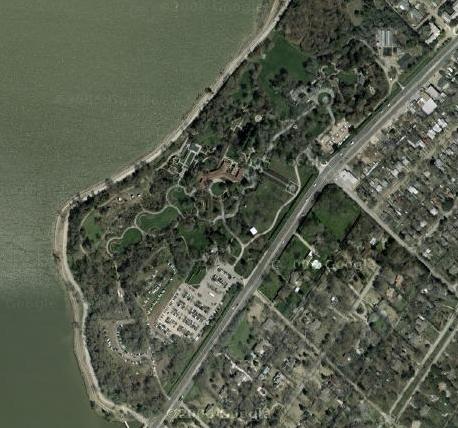 |
You can also see the maze of pathways that criss-cross the gardens.
We usually make a circular transit of the entire Arboretum each time we visit, and we are going to do the same today to try to ensure that Rudolf gets a chance see everything. I know that is probably not important for you to know where in the gardens each of our pictures were taken, but I always think it is interesting to let you follow along with us on a map or diagram. Below is a large diagram of the Dallas Arboretum, with our general route marked in yellow and the major gardens noted in red.
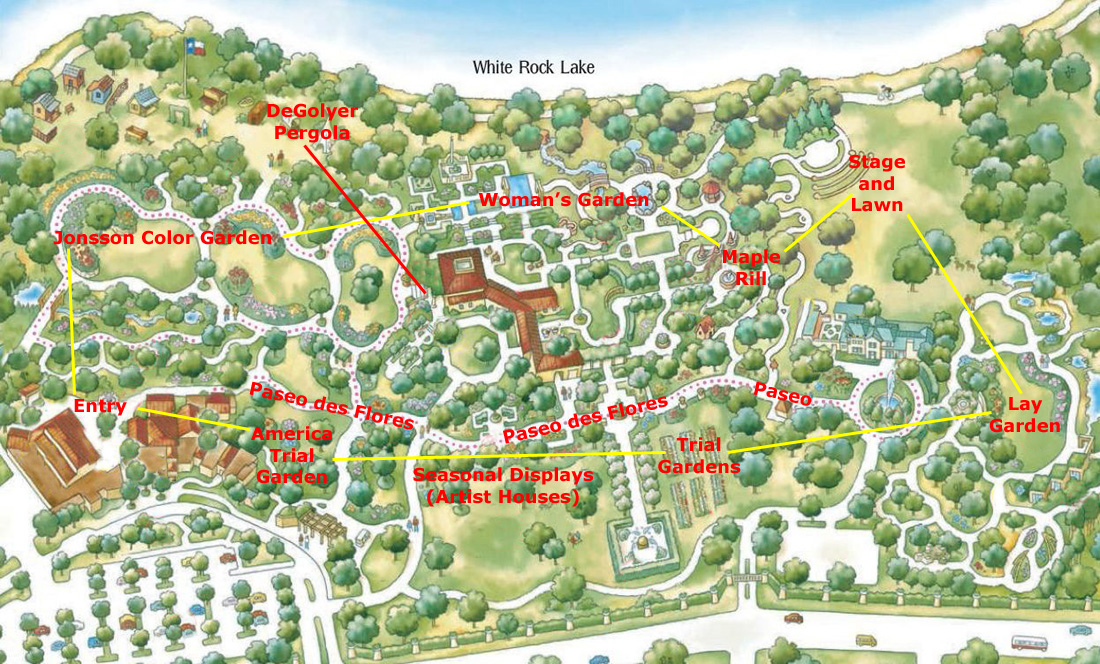
|
I'll divide up today's pictures by garden, and with each group you'll find a little inset map with our current location marked.
Ginsburg Plaza
|
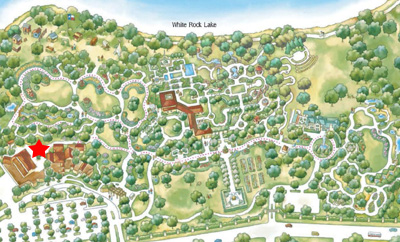
|
The Ginsburg Plaza is the entry point for the Arboretum; it is situated between the restaurant, gift shop and educational center. At some times of the year, there are a great many potted plants around the plaza, reflecting what is going on in the garden. There is also a nice fountain we sometimes stop at, but today the selection of plants wasn't that noteworthy so we headed directly on into the garden.
The Palmer Fern Dell
|
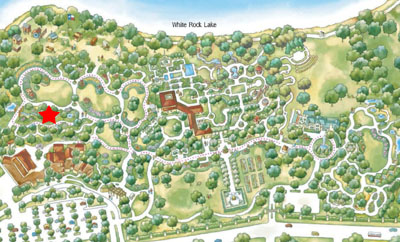
|
The Palmer Fern Dell, designed by Naud Burnett II, is located just west southwest of the Arboretum's main lawn. This tranquil spot is a welcome oasis during the summer months due to the micro-fine mist system that regularly envelops the garden. Of course, at this time of year, the summer heat means that the misting system must come on frequently, otherwise the delicate ferns would probably not survive.
The Jonsson Color Garden
|
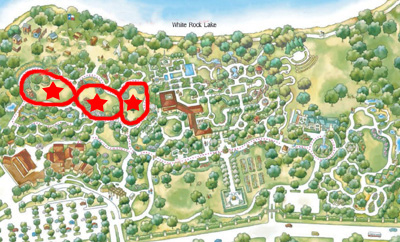 |
Today, the main lawn sports two topiary peacocks; the peacocks' bodies were made from various grasses and ivies attached to a substructure; they were not actually shaped shrubbery. The tails of the peacocks were rows of different colored flowers to simulate the designs one might actually see on their feathers. Click on the thumbnail images below to see some additional pictures we took of the peacocks:
 |
We walked across the westernmost garden and continued straight towards the second peacock on the center lawn, and then walked off the lawn and back onto the north walkway around it.
|
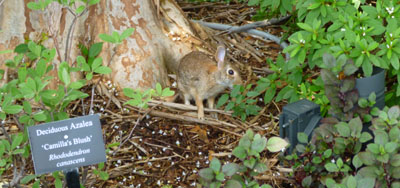 |
At one point, Fred noticed a small hare at the base of one of the trees that border the walkway, and so we had to photograph it. You can see it above at the base of the tree, and you can also see a close-up of the little animal here.
We continued along the north side of the Jonsson Color Garden to reach the entry to the Woman's Garden.
A Woman's Garden
|
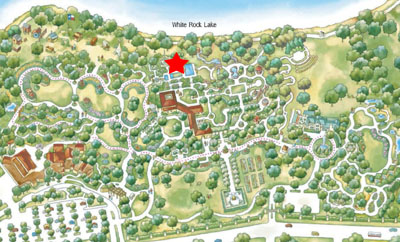 |
This 1.8-acre formal garden, which opened to national acclaim in 1997, was a gift to the Arboretum by its Women's Council. Designed by landscape architect Morgan Wheelock, it is comprised of several small garden "rooms". The dramatic focal point is a reflecting pool that provides a water-on-water view overlooking tranquil White Rock Lake.
|
One of the "rooms" of this garden is the sunken garden, one level below the main level between the garden and White Rock Lake. Stairs lead down into this garden from the lawn of the Woman's Garden, but one can also enter through another of the garden's rooms- a small formal garden with patterned boxwood shrubs, seasonal flowers, and the statue of a young girl next to the tree in the middle of it.
From the sunken garden room, we walked down what one might think of as another room- a tree‑shaded hallway to the next garden- the Red Maple Rill.
The Red Maple Rill
|
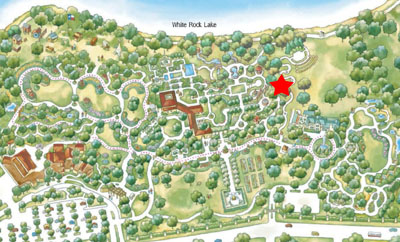 |
The main design elements include a new entry off the Paseo de Flores, plus a large gathering plaza. A meandering creek with numerous waterfalls flows down the hillside, ending in a waterfall and pool with numerous lily pads. There are also some other water features, including another pool at the base of the hill. About halfway down the hill a stone bridge crosses the stream, connecting the paved walkways around the Rill with the Martin Rutchik Concert Lawn and the Magnolia Allee. At the crossing there is a small plaza, which is a great place to sit and enjoy the beauty of the Rill.
“The most impressive feature is a fabulous collection of over 80 varieties of 200 Japanese Maples,” commented Dave Forehand, Vice President of Gardens. “Two hundred trees are planted up and down the stream with an understory planting beneath the canopy. An especially large weeping Japanese maple nearly 100 years in age anchors the center of this new garden area.”
The Red Maple Rill increases the Dallas Arboretum’s collection of Acer species and cultivars to over 120 varieties. Not only is this garden a beautiful serene oasis along the Paseo, but is also a horticulturally important garden with an impressive collection of Maple species and cultivars.
Throughout the Rill, and especially down by the two pools at the base of the hill, we took numerous pictures of the plants, flowers and wildlife, and you can click on the thumbnail images below to have a look at some of these pictures:
 |
The Rory Meyers Children's Garden
|
From the entry level, at approximately #79, we could see out across the Children's Garden. In the lower right corner of the picture you can see the top of the waterfall that we will visit on our way out, and in the center you can see the rear of the building that houses the planetarium and a number of exhibits. We usually stop in there, particularly since it is the only place in the Children's Garden that is air conditioned. There are gardens on top of that building; the Moody Oasis (#93).
Moving down the walkway to my left I pass a little garden called "First Adventure," (#82) and designed for very small children to play in. Embedded in the walkway just outside that little garden is a beautiful mosaic.
We walked down to the activity building, then passed under the Texas Skywalk (#88) (we will go up onto it in just a bit and get some view of the garden from above) to come to an area called "T. Boone Pickens Pure Energy." (#85) This is an activity area for kids, situated on three raised platforms over an artificial lagoon.
|
"Pure Energy"- A Learning and Activity Area |
"Pure Energy" is anchored by a 30-foot-tall Energy Tower, and features three separate islands, each devoted to an alternative source of energy: water, wind, and sun. From an interactive machine that demonstrates how wind energy can be transformed to make things operate to high‑powered water pistols and a solar tree with leaves composed of photovoltaic cells, the exhibits in Pure Energy do deliver a dose of science education in a highly-interactive environment.
Personally, I enjoy shooting the giant water pistols at the designated targets to make the turn or go up and down; and I am sure the kids do, too. Rudolf certainly did. (I did discover on my first experience with the pistols that while they can be swung left and right to hit the various targets in the lagoon, the water pressure is calculated so you can't hit people on the islands (I tried) and the pivots have governors that prevent you from turning them so much to the left or right that you can hit people on the walkways (I tried).
|
The Wind Sculptures |
 |
On the walkway alongside the islands, there are a series of wind‑activated sculptures, and you can use the player at left to watch the movie that Fred made of them.
To get an overview of the entire Children's Garden, the best place to be is up on the Texas Skywalk. It is a walkway about twenty feet up in the air that connects from a point near the entrance plaza to the Energy Tower.
|
Click on the thumbnail images below to see some of the pictures we took from the skywalk:

|
At the end of the skywalk nearest the entry, we are right by the planetarium building again, looking down the pathway and stairs that take you to the base of the waterfall that I mentioned earlier- the one that flows over a glass roof and then falls, in a sheer curtain of water, down into a recirculating pool.
|
Behind the Waterfall in the Children's Garden |
You can see a couple of pictures that we took from behind the falls here and here but you'll notice that the curtain seems not to be transparent. That's because of the fact that the camera freezes the motion when it takes a picture. Your eye doesn't do that, since it isn't taking discrete pictures, so the experience is such that only a movie can properly show it; you can use the player at left to watch the movie that I made.
Continuing on along the pathway and coming out from behind the waterfall, the walk makes a switchback to bring you up towards the entry plaza. From the point where the walkway turns and ascends, you can get a great view of the whole waterfall- the glass roof, the falls themselves, and the way the walkway goes behind them. Continuing on up the walkway brought us back to the Children's Garden entry plaza. I might mention that there is a fountain in the middle of that circular plaza, and some seating on two sides of it. During the summer, there is a misting system to keep you cool if you want to sit and watch kids play in the fountain.
I think Rudolf was impressed with the new Children's Garden, as are we.
The Rose Garden
|
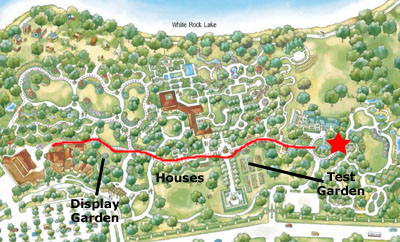
|
Fred took a few pictures of some of the roses and other flowers in the Rose Garden, and you can click on the thumbnail images below to have a look at some of them:
 |
The Test Gardens
|
Click on the thumbnail images below to see some other pictures of the plants and flowers in the test gardens:

|
The Lyda Bunker Hunt Paseo de Flores, known simply as the Paseo, is the central walkway of the Dallas Arboretum. This meandering pathway, designed by Luis Santana, runs through the center of the Arboretum, and is the walkway that we took from the test gardens all the way back to the gardens entrance near the Trammell Crow Visitor Education Pavilion. This brought us back to the Ginsburg Plaza and brought our visit to the Arboretum to an end.
You can use the links below to continue to another photo album page.
 |
Return to the page for Rudolf Lowenstein's Visit to Dallas |
 |
Return to the Index for 2014 |